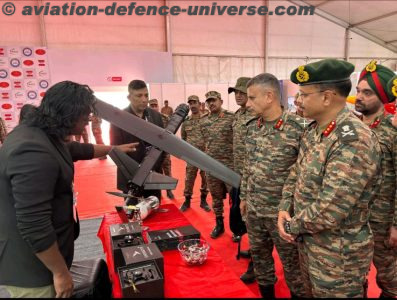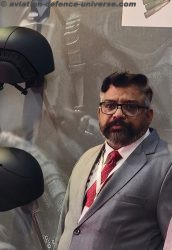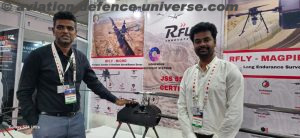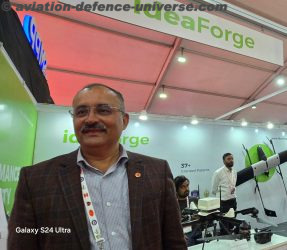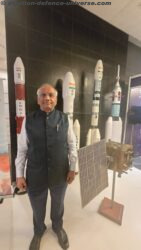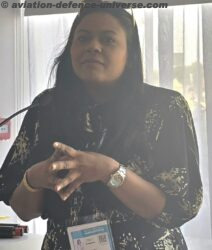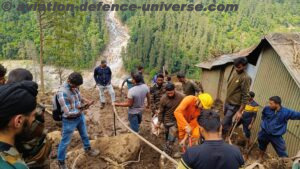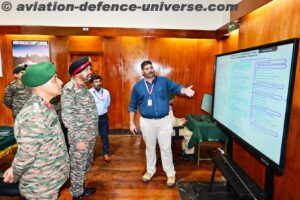- From a Navy Drone Pilot to Innovator & Manufacturer
- John’s vision for unmanned solutions for armed forces is vast
By Sangeeta Saxena
Leh/New Delhi. 30 September 2024. In high-altitude, hostile environments, manned missions can be extremely dangerous due to harsh weather conditions and enemy presence. Tactical drones minimize the need for soldiers to physically enter dangerous zones, reducing the risk of casualties while still fulfilling mission objectives. This is the modern day warfare tactics popular in many armies of the world and India is not behind in matching steps.
At the Himtech 2024 event in Leh, ADU spoke with John Livingstone, Founder, Chairman & CEO of Johnnette Group, which is on the forefront of manufacturing drones for the need of the Indian Armed Forces. A Navy Drone Pilot by background, he now leads a company focused on military drone solutions. In this candid conversation, John discusses the challenges of operating in high-altitude environments, the products Johnnette is offering to the Indian Army, and the state of the commercial and defence drone markets in India.
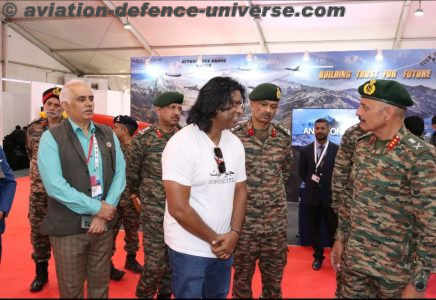 ADU. How do you plan to operate drones in harsh weather conditions like snow in Leh? What brings you to Himtek?
ADU. How do you plan to operate drones in harsh weather conditions like snow in Leh? What brings you to Himtek?
John Livingstone. We have some of the best drones and loitering munitions designed specifically for high-altitude operations with the Indian Army. Our drones have already been tested at an altitude of 17,500 feet and have been supplied to Central Command for border management and surveillance. Here they will be operating on both sides of Nepal for border management and border surveillance. At the same time, these drones are capable of doing a strike in terms of if there’s any target that has to be taken down, we can actually use them to take down the target. These are actually recoverable missile kind of a platform, platforms actually.
ADU. How do your drones perform in extreme weather conditions, such as deserts or freezing temperatures?
John Livingstone. Our JF2 drones have been tested in the Thar Desert at temperatures as high as 58°C and as low as -30°C in Leh. They’re already being used by the Indian Army’s Western Command and are designed to be crash-resistant, making them highly durable for challenging terrains.
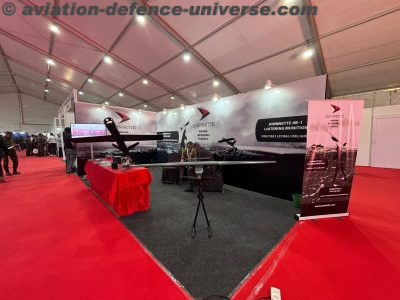 ADU. What products are you showcasing at Himtech 2024 that the Indian Army might adopt?
ADU. What products are you showcasing at Himtech 2024 that the Indian Army might adopt?
John Livingstone. We have two flagship products: the ISR (Intelligence, Surveillance, Reconnaissance) drone JF2 and the combat-focused loitering munition JM1. The JF2 is a tactical hand-launched drone with a range of 10–15 Kilometres and high endurance at high altitudes, while the JM1 is a kamikaze drone that self-destructs on impact, ideal for precise strikes. One is for the ISR segment. The other one is for the combat segment. For the ISR segment, we have JF2.
Let me just explain. JF2 is a tactical drone, hand launch capable drone. It flies for up to 10 Kilometres and one hour of endurance in high altitude. And on plain regions, it can fly for 15 Kilometres and almost 85 minutes of endurance. It is capable of flying both in the day and night. So we have a thermal imaging camera for night time operations. And for daytime operations, we have a UIR camera, which can be used for identifying targets like enemy vehicles or enemy personnel. And then we will be able to designate who it is, what it is.
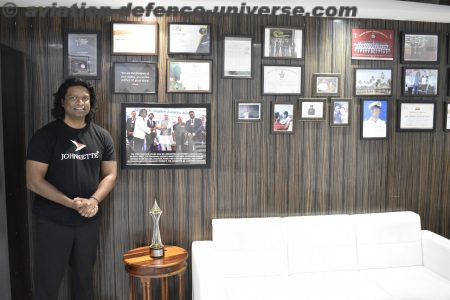 And then the second product, JM1, is a loitering munition. It’s a kamikaze drone that self-destructs itself by hitting the target. This is capable of flying up to 5 Kilometres one way and it will be airborne for 20 minutes. We will be able to also abort the mission at about 400 meters above the target if we decide to abort the mission. And it can be dropped somewhere else in a safe zone. So by identifying the enemy using the JF2 ISR drone, we will get the latitude and longitude or the position of the enemy. And that is fed into the loitering munition, that is JM1, and it goes and strikes the enemy target. So that’s how these both products are integrated to perform an operation.
And then the second product, JM1, is a loitering munition. It’s a kamikaze drone that self-destructs itself by hitting the target. This is capable of flying up to 5 Kilometres one way and it will be airborne for 20 minutes. We will be able to also abort the mission at about 400 meters above the target if we decide to abort the mission. And it can be dropped somewhere else in a safe zone. So by identifying the enemy using the JF2 ISR drone, we will get the latitude and longitude or the position of the enemy. And that is fed into the loitering munition, that is JM1, and it goes and strikes the enemy target. So that’s how these both products are integrated to perform an operation.
ADU. And what is the payload?
John Livingstone. For the loitering munition, we have about half a kg warhead. This is actually a scalable warhead. If I want to fill in more explosive in it and then I can take down, if I want to increase the destructive capacity, I can actually fill in more, a one kg warhead or something like that. And, you know, this is for the Indian Army.
ADU. Do you also cater to the Indian Air Force and Navy, or is your focus only on the Army?
John Livingstone. We are modifying both platforms for naval operations. The JF2 and JM1 are also suitable for the Indian Air Force, though they have specific needs, like long-range loitering munitions. We’re developing JM-2 and JM-3 versions for those applications.
ADU. What are your plans for exporting these drones?
John Livingstone. We’ve set up Johnnette Middle East in Dubai, with a focus on the MENA region for the next few years. Expansion into South America is planned but will happen after we solidify our presence in the Middle East and Africa.
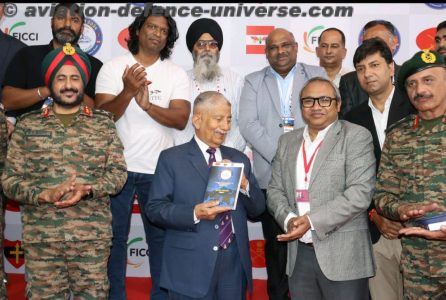 ADU. As a Navy veteran, how did you transition into the drone industry?
ADU. As a Navy veteran, how did you transition into the drone industry?
John Livingstone. My background as a certified military drone pilot, combined with the frustration of India’s dependence on foreign drones, pushed me to create Johnnette. In 2009, I started developing the idea, and after my retirement in 2014, we launched Johnnette to focus on building indigenous drones for the Indian military.
ADU. Do you see a potential MRO (Maintenance, Repair, and Overhaul) industry specifically for drones?
John Livingstone. The drone MRO market is still very nascent. MRO is more suited for large-scale operations like airlines. For now, drone repairs are manageable in-house, but if India develops its own large-scale drones, we could see a growing need for dedicated MRO services in the future.
ADU. What is your take on the commercial drone market?
John Livingstone. While there’s interest in sectors like agriculture and logistics, the demand is too low and supply very high, to justify heavy investment. In contrast, the defence drone market has a very high demand with limited supply, making it a far more lucrative a sector.
ADU. In the crowded space of tactical drones why should the Army choose Johnnette Drones?
John Livinstone. Johnnette Drones because they are just tailor made for the high altitude areas and for efficient border management. In high-altitude areas, visibility can be poor due to weather conditions like snow, fog, and clouds. Tactical drones equipped with advanced cameras (thermal imaging, infrared) provide real-time surveillance, even at night or in low-visibility situations, giving armed forces crucial intelligence on enemy movements or positions. They are quick in overcoming terrain challenges. Mountainous regions are difficult to traverse and maintain continuous observation of. Tactical drones can easily navigate steep inclines, cliffs, and valleys, giving military forces an operational advantage by reaching areas that are otherwise inaccessible to humans or traditional vehicles. Our do just this. Rapid deployment and quick mobility are the need of the hour. High-altitude warfare often requires quick responses. Tactical drones, particularly those that are hand-launched, can be deployed quickly and are portable, making them ideal for operations in remote, mountainous regions where transportation of heavy equipment is challenging. And Johnnette keeps this in mind while designing and manufacturing.
 ADU. Finally, how has Himtech 2024 been for you? Has it met your expectations in terms of exposure and footfall?
ADU. Finally, how has Himtech 2024 been for you? Has it met your expectations in terms of exposure and footfall?
John Livingstone. While we expected more high-ranking officers and dignitaries, including the Defence Minister, the footfall has been lower than anticipated. However, we’ve had good interactions with local police and paramilitary forces, who are interested in our smaller drone platforms.
John from Johnnette shared these fascinating insights into the evolving world of military drones in India. With products specifically designed for high-altitude and challenging terrains, Johnnette is setting its sights on becoming a key player in the defence drone industry. While the commercial market remains uncertain, the defence sector is where John sees the most growth and opportunity. As Johnnette continues to innovate, we can expect more advancements and exciting developments in the future. And the parting shot is he a a four time author whose passion is making the black and white read all over.
As told to Sangeeta Saxena




































